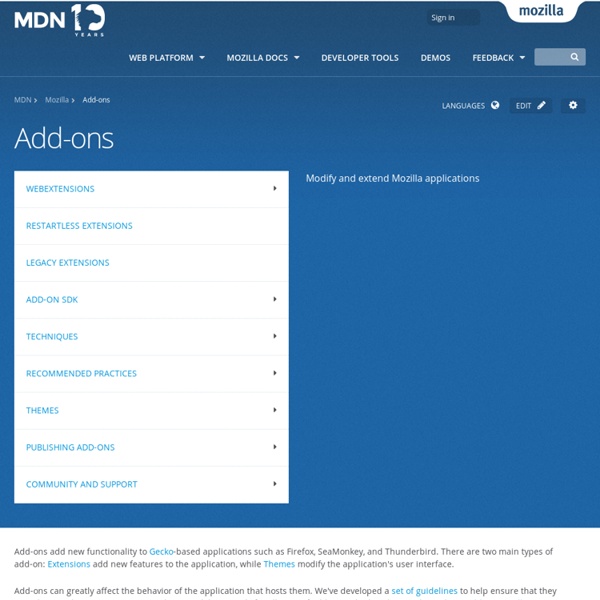Extensions

Extension Frequently Asked Questions
This is quick set of answers to the most common issues with extension development. They are currently written with mostly Firefox in mind, but most if not all should easily translate to SeaMonkey, Thunderbird or any of the other applications. For Thunderbird, you may also find the extension HowTo or FAQ pages helpful. If you're looking for a place to get started, try our tutorial, Building an Extension or MozillaZine's Getting started tutorial. Be sure to set the development preferences. Debugging You should set development preferences before attempting to debug your extension. The Venkman JavaScript debugger may be useful in complex cases, remember to turn off the "Debug -> Exclude Browser Files" option when working on extension code. How can I see errors in my code? After you set the preference javascript.options.showInConsole to true, the errors will be reported to the Error Console. How can I display what my extension is doing? Why doesn't my script run properly? or Example code
What are the key differences between JavaScript and ActionScript 3
Building an Extension
Introduction This tutorial will take you through the steps required to build a very basic extension - one which adds a status bar panel to the Firefox browser containing the text "Hello, World!". Note: The extension created by this tutorial won't work in Firefox versions that don't have a static status bar (that is, Firefox 4 and up). You can find a more up-to-date tutorial in the XUL School tutorial The Essentials of an Extension. Since Firefox 4 (and other Mozilla 2 based applications) there are two types of extensions: Traditional, classic, or XUL extensions are more powerful, but more complicated to build and require a restart to install. This article explains how to build a traditional extension for Firefox. For a tutorial on building an extension for Thunderbird, see Building a Thunderbird extension. Quick Start A Hello World extension similar to what you can generate with the Extension Wizard is explained line-by-line in another tutorial from MozillaZine Knowledge Base. <? XUL Overlays
JavaScript
JavaScript (JS) is a lightweight interpreted (or just-in-time compiled) programming language with first-class functions. While it is most well-known as the scripting language for Web pages, many non-browser environments also use it, such as Node.js, Apache CouchDB and Adobe Acrobat. JavaScript is a prototype-based, multi-paradigm, single-threaded, dynamic language, supporting object-oriented, imperative, and declarative (e.g. functional programming) styles. JavaScript's dynamic capabilities include runtime object construction, variable parameter lists, function variables, dynamic script creation (via eval), object introspection (via for...in and Object utilities), and source-code recovery (JavaScript functions store their source text and can be retrieved through toString()). This section is dedicated to the JavaScript language itself, and not the parts that are specific to Web pages or other host environments. Looking to become a front-end web developer? Get started
Related:
Related:



